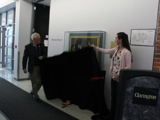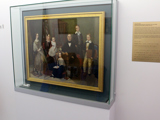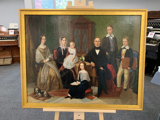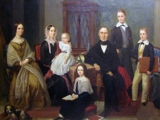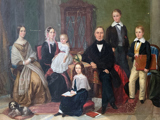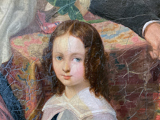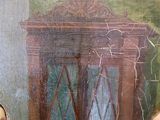Charles Bowman and Family Painting
Clarington Library, Museums & Archives would like to share an update on the Charles Bowman and Family painting and provide a sneak peek behind the scenes of this exciting conservation project!
Update, May 2023: Painting Unveiled
On Tuesday, May 23, a newly installed display of the Charles Bowman and Family Painting was unveiled in a private ceremony at the Municipal Administrative Centre in Bowmanville. This portrait was donated to the Clarington Museums and Archives in 2015 and represents an important piece of local history. It is the only known likeness of Bowmanville’s namesake, Charles Bowman.
Recently, the painting underwent professional conservation treatment. Due to its significance, and sensitivity of materials, a custom-built, climate-controlled display case was sourced in order to have the painting displayed safely. With our desire to share this unique piece of the town’s history with local residents, the newly-created display has been installed in the local government headquarters to be accessible to all.
Local residents will be able to view the Charles Bowman and Family portrait in the Municipal Administrative Centre as of Wednesday May 24, 2023.
Update, November 2022: Painting Returned
The painting has now been returned to us following the professional conservation treatment which included repairing, cleaning, and framing the canvas. We are happy to share a photo of the final results, as we understand the community’s continued interest in this project.
A custom-built display case is being constructed and once received, we will install the painting for public display. An announcement will be made regarding the official unveiling at that time.
Thank you for the continued interest and support of this project!
Update, August 2022: Conservation Treatment
As possibly one of the only surviving images of Charles Bowman and his family, this portrait is important to the history and artistic heritage of Clarington. Clarington Library, Museums & Archives is pleased to be working in conjunction with leading industry professionals to conserve, display, and interpret the Charles Bowman and Family painting for future generations.
As this work of art is over 170 years old and has passed through several generations of the Bowman family, it requires conservation care that is different than most museum artifacts. The Clarington Library, Museums & Archives have taken extra measures for the work’s safety by commissioning a specialty case which will provide proper environmental controls to ensure the painting remains stable while being displayed.
The painting is currently with a professional painting conservator, who is working on repairing, cleaning, and framing the canvas. We are happy to share these photos of the progress being made below, as the Clarington Library, Museums & Archives understand the community’s vested interest in this project.
Please click/tap on each image below to view a larger version.
More Information
Future Display
Upon completion of the conservation treatment later this year, the Clarington Public Library, Museums, and Archives will make a public announcement of the unveiling of the official Charles Bowman and Family painting display. We thank everyone for their interest and continued support of the Clarington Public Library, Museums, and Archives and look forward to sharing this important artifact with the public.
Bowmanville’s Namesake
Bowmanville was named after Charles Bowman (1790-1848), but an interesting fact is that he never lived in Bowmanville! Charles Bowman was a merchant who came to the area of Bowmanville (then called Darlington Mills) in 1824, however, he maintained his family home in Montreal. Bowman purchased 300 acres of land in Darlington Mills and purchased a general store that served the community well for many years. He also paid for a surveyor to lay out streets, donated land to churches, and people began to establish homes and businesses nearby. It is because of Bowman’s contributions to the town’s development that people began calling it Bowmanville by the 1830s.
Charles Bowman lived in the Westmount area of Montreal with his wife, Elizabeth (nee Savage), and their 5 children: Charles, Elizabeth, James, Anne, and Victoria Sophia. Sadly, only Elizabeth survived into adulthood. She married and in turn had 8 children with Captain Robert Raynes, while continuing to live in the Westmount family home.
Discovery of the Painting
A few local residents and past staff of Clarington Museums and Archives believed that a portrait of Charles Bowman and his family existed based on provenance records and anecdotes, but thought it was lost over the years.
In 2014, former Curator, Charles Taws, received a call from an individual who had information on the Bowman painting. With some research, it was discovered that the painting was given to a family friend of the Raynes (the Bowman granddaughters) and the painting went unrecognized for years. In 2015 the work was donated to the Clarington Museums and Archives and has been cared for as part of the permanent collection ever since.
The Portrait’s Significance
In this extraordinary work of art that dates from the mid 1840s, the Scottish merchant Charles Bowman and his wife, Elizabeth, are portrayed with their five children. Created by an unknown artist in oil on canvas, the relatively small dimensions of this portrait (67.3 x 85.7 cm) make the likenesses of the individuals even more impressive.
Seated to the right of centre, Charles Bowman is an engaging figure as he looks directly out at the viewer. Charles appears to have just taken a seat with his family, as a red silk-lined cloak is draped casually on his chair, and a newspaper has fallen on the ground at his feet. Not incidentally, the newspaper’s title reads “Montreal,” hinting at Bowman’s home and estate in Westmount.
Drawing on a theme of education and family legacy, the artist’s composition forms a V shape, with Bowman’s eldest son Charles as the tallest figure. Hinting at Bowman’s profession as a merchant, his youngest son, James, also holds a leather-bound portfolio that likely contains maps or drawings. A daughter, Anne, similarly pauses from her reading, while another book is found near her stool. In addition, the little dog at the bottom left of canvas is traditionally interpreted as a symbol of loyalty and domesticity. With these references, the artist implies Charles Bowman’s ability to balance professional duties with his dedication to family life.
Further Reading
Please see the below articles regarding the history of Charles Bowmanville and the return of the painting:
Contact Us
Clarington Library,
Museums & Archives
163 Church Street
Bowmanville, ON,
L1C 1T7

